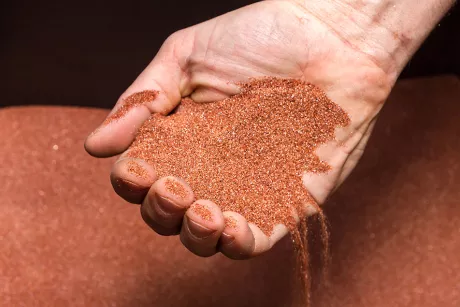Tips & Tricks
The Gem That Makes the Cut: Garnet's Role in Abrasive Waterjet
Abrasives have cut and shaped materials for centuries, all the way back to the invention of sandpaper in 13th-century China. Among abrasive products, one mineral – garnet – has risen to dominate the industry, and that same natural material dominates in the abrasive waterjet market. Garnet's physical properties, global availability and low cost make it ideal for waterjet operations as well as for other abrasive applications.
Waterjets require two specific properties from their abrasives: hardness and high specific gravity. Because these machines essentially perform high-speed erosion, the cutting stream accelerates abrasive particles but the grains themselves make the actual cut. Hardness enables the abrasive to deliver its cutting potential, whereas specific gravity means the particles have enough inertia to cut effectively because of their weight. Garnet meets all these criteria. Classified as a semi-precious stone, garnet is a naturally inert mineral that comes in two chemically different forms. Andradite garnet's softer, lighter properties make it ineffective as a cutting abrasive. The alternative, almandine garnet, dominates waterjet cutting, with a specific gravity of 4.1 and a measure of 7.5-8.0 on the Mohs scale of mineral hardness.
The two types of almandine garnet take their names from their production methods. Erosion liberates alluvial garnet from host rock and tumbles it into a riverbed, from which it deposits on a beachhead as round or nearly round grains, mined in a process more akin to dredging than to digging. Most alluvial garnet comes from Australia, China, Indian and South Africa, with very little produced in North America.

By contrast, hard-rock garnet is alluvial garnet's chemical twin, but because it has not undergone erosion, its grains yield much sharper edges, ideal for precision cutting. To extract hard-rock garnet, mining operations crush host rock and separate the mineral from it. North America dominates production of hard-rock garnet.
Mines sell garnet based on mesh size, a particle measurement, with higher numbers indicating finer grit. Since the development of the abrasive waterjet in the 1980s, 80-mesh garnet has served as its standard consumable. New developments in cutting techniques and technologies have created a range of grades for various applications. Coarse 50-mesh garnet works in applications in which cutting speed outranks edge quality in importance. Finer mesh sizes, such as 120 mesh, can produce finished-product quality off the cutting table with little to no secondary processing. Depending on grade, package size and other variables, alluvial garnet can cost between $0.25-$0.30/lb. Hard-rock garnet carries a $0.40-$0.50/lb price tag. Typical waterjet operations use approximately 1 lb of garnet per minute, with higher consumption for higher-speed performance.
With plentiful resources available on a global scale, garnet offers an ideal combination of cutting parameters and cost effectiveness for abrasive waterjet operations. Waterjet operators can look forward to years of effective high-quality cutting with garnet.




